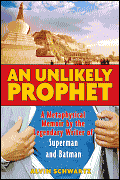
Whether this book is fiction or nonfiction (the author calls it a “book of possibilities”), it’s a good, thought-provoking read. The story, which is way too complicated to summarize here, begins when the author receives a phone call from a tulpa who was thought into materialization by an English scholar of Tibetan mysteries. This tulpa, who is seven feet tall and has a sense of humor, temporarily takes over Schwartz’s life. One reason he comes is to help him figure out what he’s been writing about. He also comes to absorb belief that turns into psychic energy that feeds him.
As the author of Superman comics during the Golden Age, Schwartz came to believe in the “real” existence of the superhero. Perhaps not real in the sense that some people believe that Sherlock Holmes lived and Conan Doyle was his secretary, but in the sense that the Man of Steel is archetypal and comes (in mysterious ways) to the aid of those who believe in him. This is not an original concept. Who among us has not clapped for Tinkerbell? In his Discworld novel, Small Gods, Terry Pratchett says that gods are like quicksilver and slip and slide into and out of existence. They are only sustained as gods by the human worship that gets them up and keeps them running.
Consider our neopagan gods and goddesses. We’re finding and recreating old gods all the time, sometimes reinventing them, as we take a totally obscure god perhaps named Cernunnos and make him the center of our attention. We’re adopting gods and goddesses from other cultures (the Tibetan Tara comes to mind) and Westernizing them. And we’re using pop culture in our rituals too—do we know anyone whose magical name comes from Tolkein? We’re building our own tulpas. We build shrines to them, we make rituals around them, and if the old myths and legends are insufficient, we make up new ones. We’re finding small gods and feeding them with psychic energy and watching them grow.
This book is majorly trippy. Is Thongden “real”? What does “real” mean, anyway? If we pay attention, we can start to re-vision the paradigm we pagans are working in and with. As a Tibetan khempo says, “Can eyes untutored in seeing see more than they have learned to see? Or ears untutored in hearing hear beyond what they have been trained to hear” (p. 79)? Is the story Schwartz tells “real”? It doesn’t matter. There are lessons to be found and thoughts to be thought.
~review by Barbara Ardinger, Ph.D.
Author: Alvin Schwartz
Destiny Books, 2006
